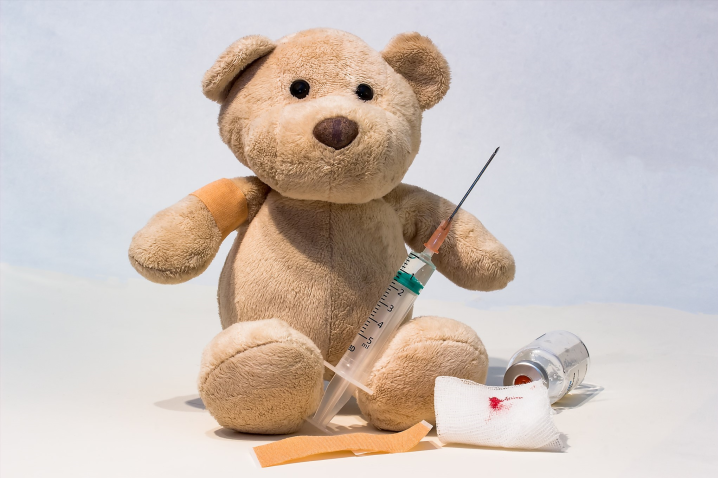This post may contain affiliate links. Please see the affiliate disclosure for more details.
Multiple Daily Injections (MDI) with a syringe, insertions from pump site changes, Continuous Glucose Monitoring (CGM) insertions, and finger pokes are sometimes mentally hard for kids. The anticipation when getting an injection or insertion is sometimes worse than the actual pain.
Tips / Products / Prescriptions
Tips
- Be Ready – minimize the amount of time spent giving injections by having the insulin, site change supplies, CGM parts, and lancets ready. Try to prepare these items out of sight.
- Make Shots/Insertions “Fun” (or feel some control) – let kids select the syringe, choose the location for the injection/insertion, press the plunger on the syringe, read the glucose meter results or have them put items in the sharps container.
- Stuffed Toy – let kids give Rufus the Bear or another stuffed toy an injection with a toy syringe.
- Have the stuffed toy be a distraction by hugging the stuffed toy during an injection. Squeezing or hugging the toy can be comforting during the injection. Make-up a story about the stuffed toy that helps your child be brave and gives them extra courage while they hug the toy tight during injections.
- Reward System – create a reward system for every injection, insertion, or finger poke. Rewards can include:
- Hugs
- Reading a book afterwards
- Fun Band-Aids
- Sticker chart/shot chart and when full or after a successful streak a treat/toy is received
- “Brave Box” with treasures/poke prizes. Most items can come from the Dollar Store or bargain bins.
- Earn “brave bucks” that are used towards a big ticket item like a trip to Disneyland or an expensive toy
- One-on-one time with Mom/Dad at the park
- Find your child’s “currency” and use it to your advantage
- Diabetic Buddy – sometimes kids just need to talk to someone else going through the same thing. Get in contact with another diabetic kid around the same age that has mastered injections/insertions/finger pokes.
- Meet in person, via Skype, or FaceTime
- Gaming system buddy (PS4 or Xbox playing a game like Fortnight)
- JDRF connects newly diagnosed families with a mentor family
- Connect on social media. Facebook has several closed groups:
- YouTube – search for videos showing kids receiving injections, giving themselves injections, changing pump sites, checking their blood sugar with a glucose meter, OminPod and CGM insertions and generally taking care of their diabetes. Watching a few videos may help.
- Distractions – provide kids with a distraction that helps take their mind off the syringe/injection/insertion/finger poke.
- Stress toys or fiddle toys (batons with glittery water, fidget spinner, squishy ball)
- Watching a video or TV. Consider wearing headphones to avoid hearing priming of pumps and injection noises.
- Ask kids to wiggle their toes as fast as they can or hold their nose. These actions tend to not allow you to think about anything else.
- Sing a song
- Cough at Insertion – theory that coughing at time of needle/cannula insertion provides a distraction that momentarily increases blood pressure reducing pain perceptions.
- Breathing/Meditation – find a breathing technique that simulates relaxation. Breathing out as the needle/cannula is inserted into the body helps relieve pain.
- Cold Object – use ice or freeze a spoon/smooth rock and place it on the skin for 2 minutes to help numb the injection site.
Products
- Buzzy – hand-held device that naturally minimizes pain from injections and finger pokes. Uses vibration, ice and distraction methods. Make sure to clean the skin with alcohol after using Buzzy. Multiple sizes available:
- Reusable Ice Pack – come in friendly kid designs and cartoon characters.
- Topical Anesthetic Creams and Cooling Sprays– cream or spray that temporarily numbs the skin of the injection/insertion site. Available in prescription strength and over the counter:
- Shotblocker – plastic device with contact points on the underside that saturates the sensory nerves distracting the pain signals caused by the injection.
- TickleFlex – insulin injection aid that makes injecting a safer, more comfortable, more consistent and worry-free process.
- Ambimed InjectEase – helps people that do not like to see needles and also helps reduce the pain of the injections.
- Autoject 2 – designed for individuals who have difficulty injecting themselves manually with a syringe. A button allows for one-handed operation inserts the needle and contents without having to see the needle. This device also helps widen the range of injection sites.
Prescriptions
- Needle Size for Injections – needle size refers to both the length and gauge (thickness) of the needle. Use the smallest gauge needle possible. Also consider if the pen or syringe is a better delivery method. Some kids find the pen less intimidating and less “shot like”.
- Finger Pokes Lancer and Lancets – look for a lancing device that offer options for changing the depth of penetration of the lancets and use the thinnest gauge lancets:
- 28 gauge is the thickest needle (hurts more)
- 30 gauge needle
- 33 gauge is the thinnest needle (hurts less)
- i-Port Advance – an injection port that is inserted once and worn for 3 days. Injections are given via the port with no pain. This prescription medical device helps reduce anxiety with syringes and pain experienced with injections.
- Insulin Pumps – receiving insulin from a pump replaces the need for multiple daily injections (MDI) at meal times and injections of long acting basal insulin. There are two types of pumps:
- Topical Anesthetic Creams – cream that temporarily numbs the skin of the injection/insertion site. Also available over the counter:
